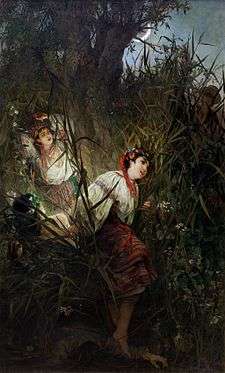Rusalka


A rusalka (Russian: Русалка) is a water nymph,[1] a female spirit in Slavic mythology and folklore. The term is sometimes translated from Bulgarian, Belarusian, Russian and Ukrainian as "mermaid".
Origin and appearance
According to Vladimir Propp, the original "rusalka" was an appellation used by Pagan Slavic tribes, who linked them with fertility and did not consider rusalki evil before the nineteenth century. They came out of the water in the spring to transfer life-giving moisture to the fields and thus helped nurture the crops.[2][3]
In nineteenth century versions, a rusalka is an unquiet, dangerous being who is no longer alive, associated with the unclean spirit. According to Dmitry Zelenin,[4] young women, who either committed suicide by drowning due to an unhappy marriage (they might have been jilted by their lovers or abused and harassed by their much older husbands) or who were violently drowned against their will (especially after becoming pregnant with unwanted children), must live out their designated time on earth as rusalki. However, the initial Slavic lore suggests that not all rusalki occurrences were linked with death from water.[3]
It is accounted by most stories that the soul of a young woman who had died in or near a river or a lake would come back to haunt that waterway. This undead rusalka is not invariably malevolent, and would be allowed to die in peace if her death is avenged. Her main purpose is, however, to lure young men, seduced by either her looks or her voice, into the depths of said waterways where she would entangle their feet with her long red hair and submerge them. Her body would instantly become very slippery and not allow the victim to cling on to her body in order to reach the surface. She would then wait until the victim had drowned, or, on some occasions, tickle them to death, as she laughed.[5] It is also believed, by a few accounts, that rusalki can change their appearance to match the tastes of men they are about to seduce, although a rusalka is generally considered to represent universal beauty, therefore is highly feared yet respected in Slavic culture.
Variations

While lore often says that the rusalki could not completely stand out of water, some fiction works tell of rusalki that could climb trees and sing songs, sit on docks with only submerged feet and comb their hair, or even join other rusalki in circle dances in the field. A particular feature of such stories revolves around the fact that this behaviour would be limited to only certain periods of the year, usually the summer (see Rusalka Week section).
Region-specific
Specifics pertaining to rusalki differed among regions. Although in most tales they lived without men, in Ukraine they were often linked with water (in Belarus they were linked with the forest and field). Where land was fertile, the maidens appeared naked and beautiful. In harsher areas of Russia, they appeared as "large breasted amazons".[6]
Rusalka Week
The rusalki were believed to be at their most dangerous during the Rusalka Week (Rusalnaya nedelja) in early June. At this time, they were supposed to have left their watery depths in order to swing on branches of birch and willow trees by night. Swimming during this week was strictly forbidden, lest mermaids would drag a swimmer down to the river floor. A common feature of the celebration of Rusalnaya was the ritual banishment or burial of the rusalki at the end of the week, which remained as entertainment in Russia, Belarus, and Ukraine until the 1930s.[7]
In literature and music
1829 – Rusalka is a short story of Orest Somov (translated into English and published in 2016[8]).
1856 – Rusalka is an opera by Alexander Dargomyzhsky.
1901 – Rusalka is an opera by Antonín Dvořák.
1989 – Rusalka, a fantasy novel, part of the The Rusalka trilogy of novels by C. J. Cherryh features and revolves around a rusalka named Eveshka.
See also
References
- ↑ Vladimir E. Alexandrov (22 May 2014). The Garland Companion to Vladimir Nabokov. Routledge. p. 597. ISBN 978-1-136-60157-6. Retrieved 12 July 2015.
- ↑ Linda J. Ivanits (15 February 1989). Russian Folk Belief. M.E. Sharpe. pp. 78–81. ISBN 978-0-7656-3088-9. Retrieved 12 July 2015.
- 1 2 Elizabeth Wayland Barber (11 February 2013). The Dancing Goddesses: Folklore, Archaeology, and the Origins of European Dance. W. W. Norton. p. 18. ISBN 978-0-393-08921-9. Retrieved 12 July 2015.
- ↑ Zelenin, D.K, cited in Ivanits, Linda J. (1992). Russian Folk Belief. M.E. Sharpe. p. 76. ISBN 0765630885.
- ↑ "Rusalka". Internet Encyclopedia of Ukraine, Canadian Institute of Ukrainian Studies. University of Toronto Press. Retrieved 12 July 2015.
- ↑ Joanna Hubbs (22 September 1993). Mother Russia: The Feminine Myth in Russian Culture. Indiana University Press. p. 29. ISBN 0-253-11578-7. Retrieved 12 July 2015.
- ↑ Ivanits, Linda, Russian Folk Belief, p. 80.
- ↑ Somov, O 2016, The Witches of Kyiv and other Gothic Tales, Sova Books, Sydney
Further reading
- Hilton, Alison. Russian folk art. Indiana University Press, 1995. ISBN 0-253-32753-9.
- Д.К. Зеленин. Очерки русской мифологии: Умершие неестественною смертью и русалки. Москва: Индрик. 1995.
External links
-
 Media related to Rusalka at Wikimedia Commons
Media related to Rusalka at Wikimedia Commons